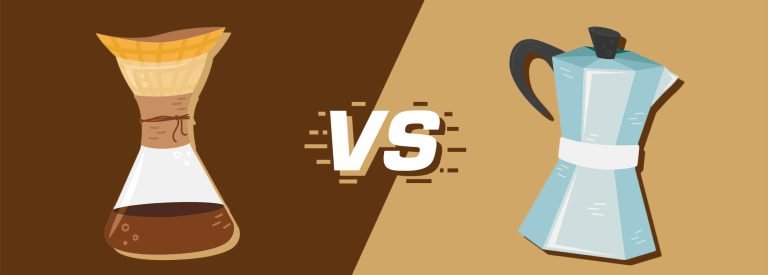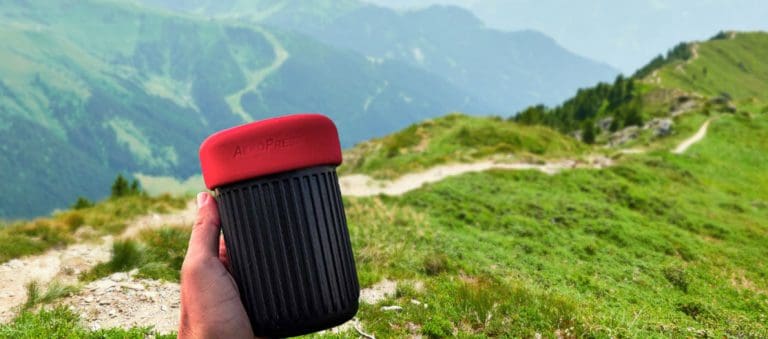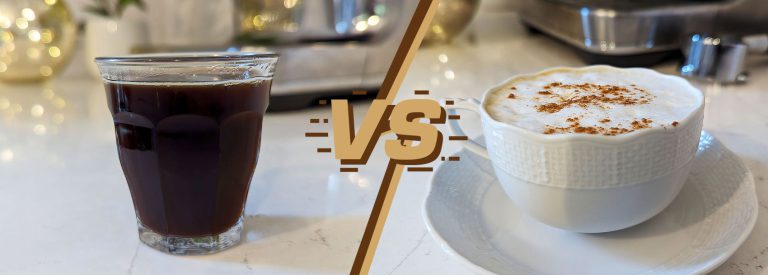Coffee vs AeroPress: The Barista’s Take
If you find yourself torn between the classic drip coffee and the innovative AeroPress, you’re not alone. Drip coffee has been around for decades while AeroPress is a newer invention, but their differences extend beyond that.
As a barista, I’ve used both methods extensively, so I understand the dilemma of choosing the perfect brewing method.
In this article, I’ll delve into the intricacies of both brewers and explore their differences to help you decide which brewing method suits you best.
Comparing Drip Coffee & AeroPress


One of the most popular ways to brew coffee is through drip coffee (more on drip coffee here). It involves an automatic drip machine that pours hot water over the ground coffee beans, which then drips down into a pot or carafe. This method has been around for decades and remains one of the simplest ways to make a cup of joe.
Meanwhile, AeroPress (read my Aeropress guide here) is a unique and innovative brewer which uses a piston mechanism that forces hot water through the coffee grounds immersed in hot water. So it combines immersion brewing with extraction under pressure through a filter. The result is a strong cup with plenty of flavor notes and nuances that might otherwise get lost during other brewing processes.
Here are the factors to consider when picking between the two brewing methods, followed by a detailed comparison of each feature:
| Features | Drip Coffee | AeroPress |
|---|---|---|
| Taste & Flavor | Smooth and well-rounded | Rich and full-flavored |
| Strength | Customizable | Varies based on recipe |
| Ease of Use | Easy to use | Relatively simple |
| Brewing Speed | 5-10 minutes | 3-4 minutes |
| Versatility | Limited control | Highly customizable |
| Durability & Portability | Not portable | Sturdy and portable |
| Sustainability | Generally unsustainable | More eco-friendly |
| Cost | Wide range of prices from $25 to hundreds of dollars | Relatively affordable from $30 to $40 |
Taste, Flavor, & Strength
Starting off with taste and strength, drip coffee is known for its simplicity and smoothness, with strength that can be customized based on the coffee-to-water ratio and roast level. It can pack quite a punch in terms of robust flavor, but still maintains a well-rounded body that’s pleasing to the palate – if you’re using quality beans, of course.
On the other hand, an AeroPress yields a rich and full-flavored cup with low acidity. Because there are various Aeropress recipes out there (from espresso-style shots to longer, more diluted cups), this device offers many different taste profiles that result from varying techniques.
Here is my favorite basic Aeropress recipe, and this great inverted recipe I’ve been using lately.
While the better-tasting coffee can be pretty subjective, I’d say that AeroPress coffee is better because it has a lot more depth in terms of flavor and strength compared to the basic drip machine. If you prefer consistency in your coffee though, then a drip machine might just be right for you.
Ease of Use
If you’re looking for a coffee maker that’s easy to use, one outshines the other.
Drip coffee is an excellent option for those who want a hassle-free brewing process. It’s easy to use because of its automated brewing process, making it simple even for beginners. Just follow the right variables like using medium-coarse ground coffee and achieving the water temperature at 195°F to 205°F. Lastly, you also need to choose the right filter type from paper, metal, or cloth filters.
AeroPress also offers an easy way of making coffee with minimal mess, but it is a more involved process. You grind your coffee to medium-fine, steep it in hot water between 175°F to 205°F (79°C to 96°C) for a given period of time, stir as needed, then press down on the plunger when the extraction process is complete. Aeropress recipes can be simple or complicated, like these Aeropress championships recipes.

All things considered, drip coffee takes the win for ease of use because it is an automatic brewer that doesn’t require you to get the timing right.
Brewing Speed
Now let’s talk about speed. Drip coffee typically takes between 5 to 10 minutes from start to finish including grinding, brewing, and cleaning up. While the machine’s brewing already takes 4 to 9 minutes depending on the machine and volume of water you are using, cleaning up also takes extra time and effort because of its removable parts. Occasional descaling with vinegar can even take longer.
The AeroPress is faster, taking about 3 to 4 minutes in total. The actual brewing process ranges from 30 seconds to 4 minutes depending on the recipe you choose. And when you’re done, cleanup is also fast and simple. Just rinse it with warm soapy water.
So in terms of speed, AeroPress takes the lead over drip coffee machines. Not only is it faster to make but it is also simpler to clean.
Versatility
It’s important for your brewing method to be versatile so you can make a perfectly customized cup of coffee that meets your individual taste.
Drip coffee makers offer some degree of control over the water-to-coffee ratio and brewing time, but many other factors are controlled automatically by the machine.
On the contrary, with AeroPress, almost every aspect of the brewing process can be tailored including water temperature, the amount of coffee, the grind size, the brewing time, and the pressure. This is why new recipes are showcased yearly at the AeroPress Championships.
When it comes to sizes and capacity, drip coffee machines are more flexible with six common sizes you can choose from:
- 4-Cup
- 6-Cup
- 8-Cup
- 10-Cup
- 12-Cup
- 14-Cup
In contrast, AeroPress is limited to its standard size which can brew up to 10 oz (290 ml) of coffee, and the Aeropress Go which can make 8oz (230 ml) at a time. Here are two Aeropress recipes for 2 people as well.
But if you have the money to upgrade, the new AeroPress XL which is double the price upsizes the OG’s capacity to 590 ml. Read my AeroPress XL review to know if this brewer is really for you.
To summarize, if you want to tweak the taste and strength of your coffee then the AeroPress is your best pick. If you like to have more control over how much you can make in every batch, then drip coffee machines may be the way to go.
Durability and Portability
So, how sturdy are these brewers? Drip coffee makers typically come in a combination of different materials such as plastic, steel, and glass for the carafe. As for their size, they often have bulkier bodies than manual brewers so these devices are not really portable. There are definite differences between the longevity of cheap vs expensive drip machines though.
Now onto the AeroPress. It is made with durable and lightweight plastic, which paired with its compact size makes it one of the most portable and durable coffee makers you can choose. To even make it sturdier, they recently rolled out the AeroPress Clear, which is made with the more durable Tritan plastic material.
Sustainability
Coffee’s sustainability is another crucial factor because it ensures that we can enjoy our daily cup of joe without leaving negative effects on the environment.
Drip coffee makers consume a lot of electricity and materials compared to other brewing methods, which does not land them on our list of eco-friendly brewing methods.
Additionally, many low-quality drip coffee brewers don’t have long operating lifespans, leading to extra waste at landfills.
You also have the paper filters to consider, but of course, you can choose metal or cloth filters as well.
The plastic construction of the AeroPress may not be ideal from a sustainability standpoint either, since plastic can be difficult to recycle. On the positive side though, this Aeropress is known to last long. The AeroPress also uses paper filters that are both recyclable and compostable. And for those who want to reduce their waste even further, there are reusable metal and cloth filters available.
Overall, while neither option is perfect when it comes to sustainability, the AeroPress edges out drip coffee as being more eco-friendly. Bulky and low-quality drip coffee makers can produce more waste over time than the AeroPress.
Cost
We then get to cost, where entry-level coffee machines are quite close to the AeroPress prices. Drip machines have a wide range of prices, starting at around $25 dollars going up to hundreds of dollars.
The AeroPress itself is relatively affordable with prices ranging from $30 to $40 depending on where you buy it. You then have replacement paper filters which cost just 2 cents each this 2025.
Both brewing methods can be affordable, with the drip machine having a lower-priced option. However, if you were to ask me, drip machines at the lowest price point do not offer great value for money so you may want to consider better models.
Drip Coffee and AeroPress – Weighing the Pros & Cons
Now that we’ve gotten a closer look at the features of each brewing method, here’s a quick overview of the pros and cons of drip coffee and AeroPress so you can finally decide which one is for you:
| Brewing Method | Pros | Cons |
|---|---|---|
| Drip Coffee | – Quick and convenient to use – Affordable for an electric brewer – Does not require your attention when brewing | – Less control over the brewing process – Not portable – The use of electricity is not eco-friendly |
| AeroPress | – Highly portable – Versatile – Produces smooth and consistent coffee – Low acidity – Fast and easy to use and clean | – Limited capacity – The plastic body is not eco-friendly |
If you’d like to know how drip coffee fares against other brewing methods, check out my other comparison articles:
Meanwhile, here’s how AeroPress compares to other brewers:
Conclusion
As you now know, AeroPress and drip coffee machines each have features that can cater to different needs, depending on which factors you give the most importance to. Drip coffee machines are easy to use and have more capacity, while the AeroPress is more portable and versatile.
For me, the AeroPress is the better choice because I like making customized brews wherever I go. But that’s just my preference. How about you, which brewer suits you better? Let me know in the comments below.








